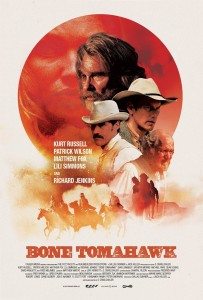 The best thing about the new western/horror flick Bone Tomahawk is without a doubt Kurt Russell’s magnificent facial hair, his moustache in particular. I’d love to see the moustache getting some work on its own, so powerful is its performance. But given the timidity of movie execs, I expect at best it’ll have to be satisfied playing Russell’s sidekick. They’re up next in Tarantino’s The Hateful Eight. Will the moustache once again prove the star? We shall see.
The best thing about the new western/horror flick Bone Tomahawk is without a doubt Kurt Russell’s magnificent facial hair, his moustache in particular. I’d love to see the moustache getting some work on its own, so powerful is its performance. But given the timidity of movie execs, I expect at best it’ll have to be satisfied playing Russell’s sidekick. They’re up next in Tarantino’s The Hateful Eight. Will the moustache once again prove the star? We shall see.
As for Bone Tomahawk, Russell himself does good work as Sheriff Hunt, given the dialogue and story he’s stuck with, and Richard Jenkins, as his deputy, Chicory, is, as ever, endlessly watchable. As for the rest of the cast, including Patrick Wilson as Arthur, Matthew Fox as Brooder, and Lili Simmons as Samantha, they’re easily out-acted by the moustache. None of them seem to realize they’re in a period piece.
Then again, most of the blame for this very confused, slow, pointless movie must rest with its writer/first-time director, S. Craig Zahler. Bone Tomahawk doesn’t know how to be what it is, so winds up not being anything.
Is it a character piece? For close to 90 minutes the four fellas ride and walk through the desert and the scrub, talking. I guess Zahler is trying to pull a Tarantino here, but absurdly long talky scenes are Tarantino’s raison d’être. They are not Zahler’s. He clearly likes the idea of having most of his movie be his four western clichés amiably chatting, but he never has them talk in such a way as to, 1) create drama, or 2) build character. Leg chewing boredom is the result.
They’re on a trek because the troglodytes kidnapped Arthur’s wife and Hunt’s other deputy, and the good guys aim to fetch ‘em back. Troglodytes, you ask? They’re like Indians—but wait! Not like the good Indians. Surely somewhere in the back of Zahler’s brain was the realization that his movie could be very easily read as saying Indians are monstrous cannibals, so he throws in a good Indian (Zahn McClarnon), dressed in a nice suit, who explains, in his one scene, that the troglodytes are Indians who went their own way long ago. They are no longer men, you see, and even Indians fear to go anywhere near them.
So, wait. Good Indians are scaredy-cat sissy boys? Guess so. Hunt and Arthur and Brooder and even old man deputy Chicory don’t think twice about heading out to face their certain deaths. To further guard against accusations of racial insensitivity, Zahler has Brooder, a seemingly rich fella dressed in a white suit, readily point out how many Indians he’s killed, much to the disgust of his three companians. Yes, even grizzled Sheriff Hunt, who’s known for shooting in the leg anyone who so much as looks at him funny, is disgusted, here on the western frontier of the 1890s, that anyone would want to kill an Indian. But troglodytes? Those bastards aren’t even human.
Arthur, meanwhile, husband of kidnapped Samantha, is so very bad-ass that he goes off to kill troglodytes with a broken leg. Seems he fell off a roof before the movie started. So in truth, the initial 90 minutes of walking through the desert might better be called, Adventures of A Man With A Broken Leg. It’s where all the drama is. Will he keep walking? Will he trip and groan in pain? Will he do so again? AND AGAIN? No, wait, what about now? Will he grimace and shout and insist that HE’S GOING TO KEEP GOING, YOU GUYS, FOR REALS THIS TIME before collapsing and then getting up agan and then collapsing and getting up again? You bet he will.
I’m not entirely sure it’s okay to introduce your leading man with a broken leg. If the fact of immobility creates the basis of your story, sure. But in Bone Tomahawk, the broken leg doesn’t stop Arthur from doing anything. He reaches the troglodytes like everyone else, and winds up shooting quite a few more of them. He just moans and cries a lot before getting there. Feels like artifical drama for a movie lacking actual drama.
From the very first scene of the movie, something’s off, and continues to be off throughout. The dialogue strives to contain old-timey words and phrasings, but they drift in and out so often it feels like everyone’s acting in a different movie. Scenes contain attempts at dramatization, yet none quite work. Visually, the movie is hampered by its pristine, bright, digital cinematography. It reminds one of television more than the old west.
The troglodytes are as thinly imagined as the rest of the movie. They’re covered in mud and have weird bone whistles embedded in their throats and they attack by running at you and hitting you with stuff unless you shoot them first. Which is to say they’re not especially threatening. As long as you see one coming, bang, they’re dead. Also, they are clearly, in fact, men, contrary to the good Indian’s opinion. They’re not monsters in a monster movie. Unless you think especially mean Indians are monsters. Which actually many people did think in them days. But not the people in this movie.
I mean it leads one to wonder what a writer with something to say would do with this story. The troglodytes literally embody Indians as imagined by people of the era: bone-wearing, mud-covered, inhuman monsters who kidnap women and eat them. Zahler has taken the stereotypical image of the “other” and literalized it, but without any comment or context, aside from some feeble ass-covering should anyone point out what he’s done. The more I think about it, the more appalling it’s becoming.
Well. Back to the dull story. Once our heroes are captured and caged, the troglodytes tear apart this one fella in a very nasty way before cooking and eating him. But we never see how the troglodytes live. All we get is one cave where no more than three ever turn up at once. We’re told there’s twelve in total, and what with their being so readily shot, you have to wonder how they’ve lasted so long. A glimpse of a pair of brutalized pregnant female troglodytes suggests troglodyte reproduction isn’t handled nearly as effectively as a tribe hoping to endure might handle it.
Speaking of which, in what barely counts as a spoiler, Samantha is found alive and well. Considering what the troglodytes do to their own women, why have they left her untouched, sitting in a cage? It feels as if no thought was given to these evil Indians, I’m sorry, troglodytes, outside of their look and their cannibalistic nature.
Bone Tomahawk might have been a palatable (albeit carelessly racist) horror flick if 45 minutes had been cut from its 130 minute runtime. Ripe dialogue and unchanging characters are fine in a bloody genre exercise. But if your movie is almost all talk, it requires characters who deepen over time, who if they don’t evolve at least reveal themselves to be more complex than what you initially imagined. When what they say isn’t funny, clever, or directed towards theme, plot, or character, it’s a waste of time.

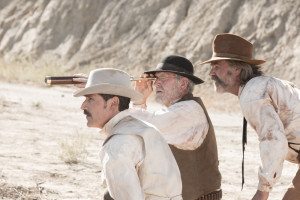
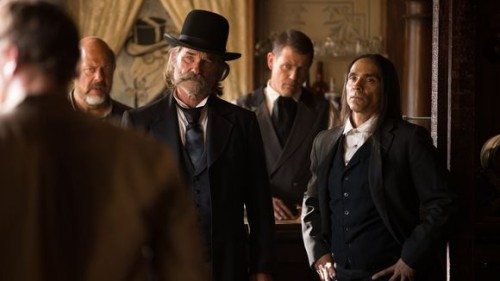
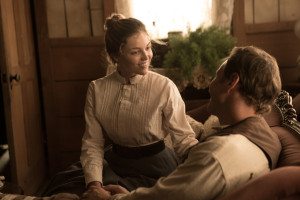
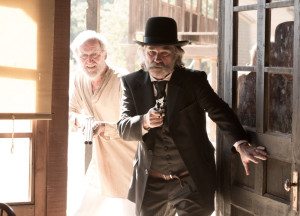
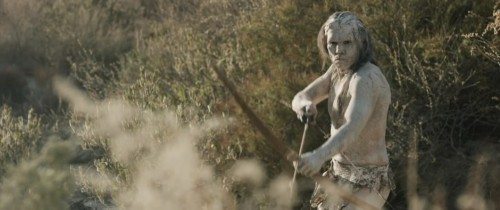
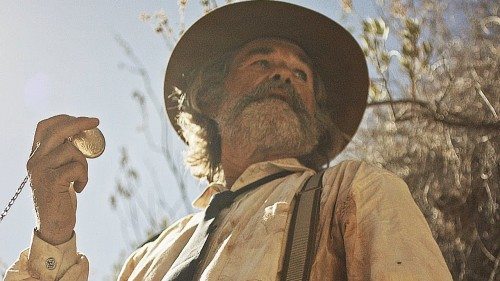
Seems like a shameful waste of Kurt Russell. On the other hand, Kurt Russell presumably got paid, so there’s that. I think I’d far rather watch Big Trouble in Little China again. Mullet beats moustache.
I’d definitely pay to see Jack Burton flail away at some troglodytes.
So…you’re basically saying there is no way to make a movie where anyone who is a Native American plays the villain? Please, please, please do not jump on the PC bandwagon. it is utterly beneath you, but there are disturbing echoes of it throughout your review. Don’t join the herd.
Well I’d hate to have disturbing echoes in my piece. Perhaps they exist. I was somewhat figuring out my thoughts as I wrote, so maybe I didn’t make my points well.
Native American villains are fine by me. I’d like them best if they were portrayed as identifiably human, with actual depth beyond the caricatures presented in more old-timey westerns. If one wanted not to have deeply realized vilains, if one wanted to present them through the eyes of the homesteaders as, essentially, monsters, you could do that too, as long as you understood what you were doing. It would need to be clear what the viewpoint was. Even then, it’s still a bit of a tricky thing to portray as one dimensional monsters a people who have in reality been close to exterminated, and who in movies have historically been portrayed as one dimensional monsters. But sure. No reason it couldn’t be done.
Bone Tomahawk does none of this. It wants to have Native American villains, but that’s hard to do–see above–so instead pseudo Native Americans are invented and called troglodytes. The trogs, as I wrote in the piece, embody all the worst stereotypical attitudes people of the time–and of still later times, sad to say–had about Native Americans. Are they shown, then, through the viewpoint of the white characters? Are we supposed to understand that the villains are in effect unreal? That they’re just regular Indians but that we’re seeing them through the eyes of prejudiced viewers? Nope. They’re bad guy monsters and must be destroyed.
But all told, the main problem with the movie is that it just isn’t very good. It tries to be a variety of things, none of them well. So in the end, time spent discussing any deeper notions it might bring up feels wasted.
I have to agree. Compared with the more accurate, human portrayal of indian protagonist and antagonists in the Revenant, this film comes off as accidentally racist, and carelessly othering.
Now, if all of it had been portrayed as against the Apaches, I agree the political landscape would have possibly descended upon the director. But, wait… then again there is the acclaim of the Revenant, and the fact that Hollywood is not the weak, lobby free, defenseless group (as real natives are). So what would have happened? Probably nothing.
Meanwhile, othering aboriginals is, imo, not acceptable anymore, even if you make them into Predator knockoffs.
Warriors of the Rainbow is a film depicting actual events of headhunters (not cannibals, grant you, but closer) in their fight against the Japanese in Taiwan. By comparison although the protagonist is a headhunter, he isn’t completely endearable to the modern mind. Yet is respectfully and HUMANLY portrayed. Different genre? OK. Western-horror vs. period-war-piece. However, does that mean such dehumanizing is acceptable?
Oh, the “savages” don’t speak languages, just blow horns. OK. But there is not a single showcase of their inner culture, except how they apparently are the height of mysogynists (as opposed to the Victorians of the era).
Oh, so are we just trying to show how normal racism and sexism was to the 1890’s “idiot” white male. Never mind that the “stupid white male” is a current media trope. Let’s suppose that the authors meant to portray these idiots (right from the front scene) as completely oblivious, well-intentioned heroes, bumbling along. And after all… of the four, the Indian (and Mexican) killer “gets his” while the Sherriff goes out with an honorable bang. A symbol of “how the west was won”.
So we’re being fair, chronological, and a bit documentarian? Othering for the sake… hmm… somehow doesn’t seem equal. More like shooting fish in a barrel.
But, I understand the idea that if there are NO villains and NO being allowed to make movies if they aren’t PC this might upset the whole genre and movie making… OK, So don’t make movies like this at all. I mean picking on a defenseless (non-existent) culture, who happens to look like a sizable group of actual aboriginals in the world for the sense of gore and faint heroism depicted in Bone Tomahawk by completely dehumanizing them is low. Even for Hollywood. It just goes to show you that “progress” is after all, quite relative. At least hollywood knows it can’t make films like this without a few re-toolings. But for my money I’d rather see Hollywood evolve and grow up.
Audiences can handle actual historical natives – yes even with gruesome scalping scenes – and be smart enough to keep it in historical perspective. Revenant: teach an old dog new tricks!
Would I recommend this film? Not past about 20 minutes. The best scenes are all early on.
Worst review I’ve read in years. Thought I wouldn’t expect any less by someone who goes by the name “supreme being”
And yours is the worst comment I’ve ever approved. Does that make us even?
Just found this review and I totally agree. I’ve been flabbergasted by the love this movie is getting. It’s like watching four dudes camping in real time. It’s like someone doubled the run time of Hellman’s The Shooting but threw some gore in at the end. The dialogue is like Charles Portis with a chromosome deficiency (“You been squirtin lemon juice in my eyes since I came in here”). A tight 90 minutes would’ve made for at least a mediocre film. At its current length it’s simply insufferable.
Thankfully, we’re not all insane. And to go off on a tangent, I’ve been reading everything by Portis lately, and finding all of it hilarious and amazing.